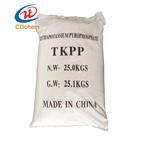| Company Name: |
Dev International
|
| Tel: |
08069013894Ext 600 |
| Email: |
|
| Products Intro: |
Cas:7320-34-5
ProductName:Tetrapotassium Pyrophosphate
|
- TETRAPOTASSIUM PHOSPHATE
-

- $0.00 / 25kg
-
2023-10-25
- CAS:7320-34-5
- Min. Order: 25000kg
- Purity: 98%MIN
- Supply Ability: 100000
|
| Product Name: | Tetrapotassium Pyrophosphate | | Synonyms: | Potassium Diphosphate 〔Potassium Pyrophosphate〕;Potassium pyrophosphate tetrabasic;PYROPHOSPHATE TETRAPOTASSIUM*PRACTICAL GRADE;TetraPotassiumPyrophosphateTechGrade;Tetra-PotassiumPyrophosphateExtraPure;TkppLiquid60%;TkppAnhydrous-TetrapotassiumPyrophosphate;TetraPotassiumPyrophosphateFoodGrade | | CAS: | 7320-34-5 | | MF: | K4O7P2 | | MW: | 330.336522 | | EINECS: | 230-785-7 | | Product Categories: | Food Additives;Inorganics;7320-34-5 | | Mol File: | 7320-34-5.mol |  |
| | Tetrapotassium Pyrophosphate Chemical Properties |
| Melting point | 1300 °C (lit.) | | density | 2.33 | | vapor pressure | 0Pa at 20℃ | | solubility | soluble in H | | form | Powder | | color | White | | PH | pH (40g/l, 25℃) : 10.0~11.0 | | Odor | Odorless | | PH Range | 10 | | Water Solubility | SOLUBLE | | Sensitive | Hygroscopic | | Merck | 14,7663 | | InChI | InChI=1S/4K.H4O7P2/c;;;;1-8(2,3)7-9(4,5)6/h;;;;(H2,1,2,3)(H2,4,5,6)/q4*+1;/p-4 | | InChIKey | RYCLIXPGLDDLTM-UHFFFAOYSA-J | | SMILES | [K+].[K+].[K+].[K+].P(OP([O-])([O-])=O)([O-])([O-])=O | | CAS DataBase Reference | 7320-34-5(CAS DataBase Reference) | | EPA Substance Registry System | Tetrapotassium pyrophosphate (7320-34-5) |
| Hazard Codes | Xi | | Risk Statements | 36/37/38-36 | | Safety Statements | 26-36-22 | | WGK Germany | 2 | | RTECS | JL6735000 | | TSCA | Yes | | HS Code | 28353990 | | Toxicity | LD50 skin in rabbit: > 4640mg/kg |
| | Tetrapotassium Pyrophosphate Usage And Synthesis |
| Chemical Properties | Tetrapotassium pyrophosphate is a white crystalline powder or granules and has a strong moisture absorption capability in air and is easily soluble in water but insoluble in ethanol. Its aqueous solution is alkaline and has effect on inhibition of food spoilage and fermentation. 
| | Uses | Tetrapotassium pyrophosphate is mostly used in combination with other condensed phosphates. It is commonly used for preventing the generation of struvite in canned fish, preventing the discoloration of canned fruit, increasing the swelling degree of ice cream, the extracting amount of the raw materials of coffee as well as the yield of ham and sausage.
| | Preparation |
Tetrapotassium pyrophosphate is produced by the reaction of furnace-grade phosphoric acid with sodium carbonate to form disodium phosphate, which is then heated to 450 °C to form Tetrapotassium pyrophosphate:
2 Na2HPO4 → Na4P2O7 + H2O
| | Health Hazard | Highly toxic, may be fatal if inhaled, swallowed or absorbed through skin. Avoid any skin contact. Effects of contact or inhalation may be delayed. Fire may produce irritating, corrosive and/or toxic gases. Runoff from fire control or dilution water may be corrosive and/or toxic and cause pollution.
| | Toxicity evaluation |
ADI 0~70mg/k (the total amount of phosphorus calculated from phosphate; FAO/WHO, 2001).
It may cause kidney stones in large doses.
Adl 0~70 mg/kg (in terms of phosphorus); According to the provision of the FAO/WHO (1984): for the processed cheese, the total phosphate is 9 g/kg (in terms of phosphorus); luncheon meat: 3 g/kg; frozen shrimp or prawns: 5 g/kg; cooked meat 3 g/kg (based on anhydrous matter).
|
| | Tetrapotassium Pyrophosphate Preparation Products And Raw materials |
|